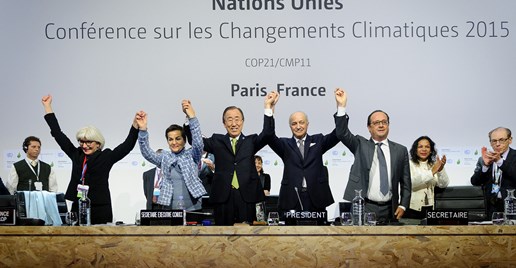Mike Daly explores the implications of the ‘Paris Agreement’ for the future of the hydrocarbon industry.
 The “Paris Agreement” of 12 December 2015 has been described as the most ambitious climate agreement to date. It has been widely celebrated and on several levels the agreement is a success. In particular, it marks the first time that both developed and developing nations have committed to reducing emissions and agreed on a temperature change target; it acknowledges that developing countries will take longer to reduce emissions than developed countries will; it is highly aspirational in banking the 2°C limit and “pursuing efforts to limit the temperature increase to 1.5 °C”; it has an element of performance follow through, by reviewing each country’s voluntary plans for reducing emissions every five years.
The “Paris Agreement” of 12 December 2015 has been described as the most ambitious climate agreement to date. It has been widely celebrated and on several levels the agreement is a success. In particular, it marks the first time that both developed and developing nations have committed to reducing emissions and agreed on a temperature change target; it acknowledges that developing countries will take longer to reduce emissions than developed countries will; it is highly aspirational in banking the 2°C limit and “pursuing efforts to limit the temperature increase to 1.5 °C”; it has an element of performance follow through, by reviewing each country’s voluntary plans for reducing emissions every five years.
Through these and many other features, the Paris Agreement has established globally the recognition of the threat of anthropogenic climate change and the need for collective action to limit global warming.
However, the Paris Agreement contains no direct references to limiting the production or growth of fossil fuels. It does not mention two of the biggest-polluting sectors – international shipping and aviation – nor does it deal with the phasing out of fossil fuel subsidies, a crucial tool in addressing climate change.
It does push out, until the second half of this century, achieving a balance between the emission and removal of atmospheric GHG. Thereby accepting the inevitable growth of CO2 in the atmosphere throughout most, if not all, of this century. This one point appears to be a major issue in achieving the 2°C limit, along with little progress on the issue of a price for carbon.
In conclusion, the Paris Agreement’s direction is clear, the target is to limit climate change to 2°C. However, the target is not deliverable through the current agreement. This highlights the gap between political rhetoric and industrial reality; the world’s reliance on coal, oil and gas is deeply structural, costly to change, and shows few signs of weakening in the next decade.
The Paris Agreement will not change this, but it does mark the beginning of a serious, global commitment to build plans to transition away from a carbon based society. The fact that the plans are non-binding is both their strength, through ownership, and their weakness, through delivery. However, they do represent a global intent from which the energy transition can emerge at a far greater pace than without them.
Key points
 No enforceable obligations. The national climate plans (the Intended Nationally Determined Contributions) submitted voluntarily before Paris are recognised under the Agreement, but are not legally binding. Thus there is no mechanism to hold countries accountable if they fail to meet their stated targets. Crucially, the Paris Agreement includes a provision to review the emission reduction pledges every five years in an attempt, through ‘peer pressure’, to strengthen them in order to meet the 2°C warming limit, a target which the current pledges do not meet.
No enforceable obligations. The national climate plans (the Intended Nationally Determined Contributions) submitted voluntarily before Paris are recognised under the Agreement, but are not legally binding. Thus there is no mechanism to hold countries accountable if they fail to meet their stated targets. Crucially, the Paris Agreement includes a provision to review the emission reduction pledges every five years in an attempt, through ‘peer pressure’, to strengthen them in order to meet the 2°C warming limit, a target which the current pledges do not meet.
A new direction is set. The aspirational aspect of the Paris Agreement and the common direction taken by all countries is hoped to provide a strong signal to the market that a gradually shift away from fossil fuels and toward investment in clean energy and technology is inevitable. The non-legally binding nature of the Paris Agreement will add pressure on governments and business to accelerate the low-carbon economy – deviation from this path is now less of a socially acceptable option. Governments, global businesses and institutional investors alike can expect increasing scrutiny by the public on their medium to long term emission reduction plans.
Putting it into action. The Paris Agreement does not detail how governments should meet their stated targets, but recognises tools such as domestic policies and carbon pricing. Key to watch therefore will be how countries put their individual climate action plans into practice (and how successfully). The business community has voiced its preference for a bottom-up, market-based approach in the form of carbon pricing over top-down government action of ‘picking winners’. A global price for carbon is widely recognised as the foundation for a coherent global energy policy, and proponents envisage that a gradual link-up of existing carbon tax and cap-and-trade markets around the world can serve as a first step in this direction.
Hydrocarbons. The fossil fuel industry should see this as a warning, not for the next decade, but certainly for their longer-term futures. Little will change tomorrow, but the Paris Agreement represents a new commitment in the world’s attempt to decarbonise, and it may come to represent a ‘licence to disrupt’. The coal industry will increasingly be targeted, even as it grows in India and China, and thrives in Europe. The replacement of coal by gas is not specifically advocated by the Paris Agreement, but this is the largest leverage coal burning countries have to reduce their emissions under present technologies and costs.
In oil the biggest concern must be with the large resource-owning countries who will always want to exploit their endowment. Oil demand will continue to grow as the global population grows and becomes increasingly mobile. However, disruptive alternatives, freshly inspired by Paris, may increasingly present society with alternatives. The high cost, deepwater, Arctic and unconventional oil developments, deferred by current prices, may wait a long time for their day. This issue will occupy much more boardroom discussion than previously, and probably heralds a changing rhetoric from major companies. However, the movement of investment from fossil fuels to renewables will continue to be difficult to justify, even at low oil prices, until carbon has a globally recognised and enforced price.
 * Mike Daly is a Visiting Professor in Earth Sciences at The University of Oxford. He is also a Senior Director at Macro Advisory Partners, and serves as a non-executive director with Tullow Oil and CGG.
* Mike Daly is a Visiting Professor in Earth Sciences at The University of Oxford. He is also a Senior Director at Macro Advisory Partners, and serves as a non-executive director with Tullow Oil and CGG.